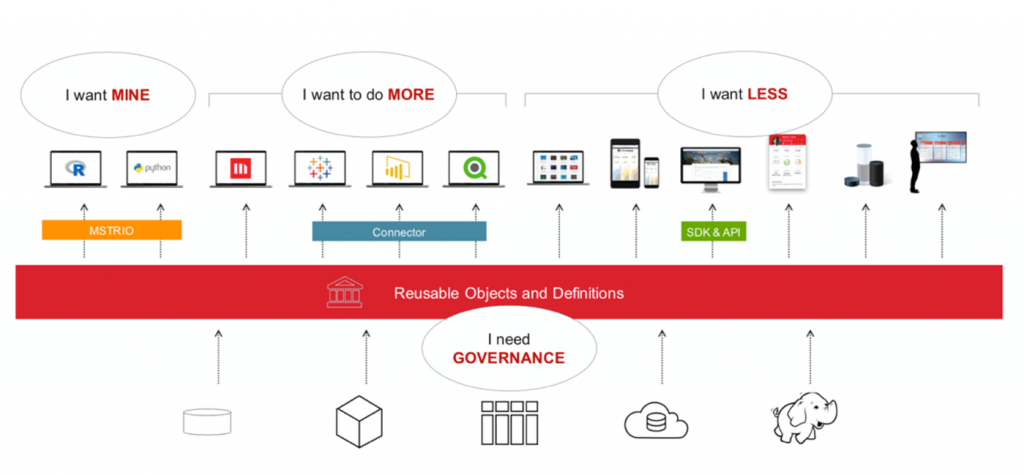Ⓒ 2023 Kyligence, Inc. All rights reserved.
What is a semantic layer in MicroStrategy?

Introduction
In today's data-driven world, businesses need to make informed decisions based on accurate and timely information. MicroStrategy is a powerful business intelligence tool that helps organizations analyze data to gain insights and make better decisions. One of the key features of MicroStrategy is its semantic layer, which plays a crucial role in data modeling and analysis.
A semantic layer is a virtual layer that sits between the physical data sources and the end-users. It acts as a bridge between the complex data structures of the underlying data sources and the simplified view of data that the end-users see. The semantic layer provides a logical representation of the data, which makes it easier for end-users to access and analyze data without needing to understand the underlying data structures.
In MicroStrategy, the semantic layer is an essential component of the platform. It enables users to create reports, dashboards, and visualizations without needing to know the underlying data structures. The semantic layer also provides a consistent view of data across the organization, ensuring that everyone is using the same definitions and calculations.
In this article, we will explore the concept of a semantic layer in MicroStrategy in more detail. We will explain how it works, its advantages, and its capabilities. We will also discuss MicroStrategy's semantic layer capability and provide an overview of the modeling tools available in MicroStrategy. By the end of this article, you will have a better understanding of the importance of a semantic layer in MicroStrategy and how it can improve data analysis and interpretation.
What is a Semantic Layer?
A semantic layer is a virtual layer that sits between the physical data sources and the end-users in MicroStrategy. It provides a simplified view of the data to the users, making it easier for them to access and analyze the data. The semantic layer acts as a bridge between the complex data structures and the end-users, providing a common language for data interpretation.
In MicroStrategy, the semantic layer is created using a metadata repository that contains information about the data sources, data structures, and business rules. The metadata repository is used to create a logical data model that defines the relationships between the data elements and provides a unified view of the data.
The semantic layer in MicroStrategy provides several benefits, including simplified data access and analysis, consistency and accuracy in data interpretation, and data governance and security. By providing a simplified view of the data, the semantic layer makes it easier for users to access and analyze the data. It also ensures that the data is interpreted consistently and accurately across the organization.
Compared to other data modeling methods, such as physical and logical modeling, the semantic layer provides a more flexible and agile approach to data modeling. Physical modeling involves creating a physical representation of the data, which can be time-consuming and inflexible. Logical modeling involves creating a logical representation of the data, which can be complex and difficult to maintain. The semantic layer, on the other hand, provides a virtual representation of the data that can be easily modified and maintained.
In summary, the semantic layer in MicroStrategy provides a simplified view of the data to the end-users, making it easier for them to access and analyze the data. It provides several benefits, including simplified data access and analysis, consistency and accuracy in data interpretation, and data governance and security. Compared to other data modeling methods, the semantic layer provides a more flexible and agile approach to data modeling.
Advantages of a Semantic Layer in MicroStrategy
A semantic layer in MicroStrategy offers several advantages that make it an essential component of data analysis. This section will discuss the benefits of using a semantic layer in MicroStrategy, including simplified data access and analysis, consistency and accuracy in data interpretation, and data governance and security.
Simplified Data Access and Analysis
One of the primary benefits of using a semantic layer in MicroStrategy is that it simplifies data access and analysis. A semantic layer acts as a bridge between the physical data sources and the end-users, providing a simplified view of the data. This simplified view makes it easier for end-users to access and analyze the data without needing to understand the underlying data structures and relationships.
For example, a business analyst may need to analyze sales data from multiple sources, including transactional databases, spreadsheets, and cloud-based applications. Without a semantic layer, the analyst would need to understand the data structures and relationships of each data source to create a unified view of the data. With a semantic layer, the analyst can access a single, unified view of the data, simplifying the analysis process.
Consistency and Accuracy in Data Interpretation
Another benefit of using a semantic layer in MicroStrategy is that it ensures consistency and accuracy in data interpretation. A semantic layer provides a standardized view of the data, ensuring that all end-users interpret the data in the same way. This consistency in data interpretation is essential for making informed business decisions based on accurate data.
For example, suppose a sales manager needs to compare sales data from different regions to identify trends and opportunities. Without a semantic layer, the manager may encounter inconsistencies in the data due to differences in data structures and relationships. With a semantic layer, the manager can access a standardized view of the data, ensuring consistency and accuracy in data interpretation.
Data Governance and Security
Finally, a semantic layer in MicroStrategy improves data governance and security. A semantic layer provides a centralized view of the data, making it easier to manage and secure. Data governance policies can be applied to the semantic layer, ensuring that all end-users access the data according to established policies and procedures.
For example, a healthcare organization may need to ensure that patient data is accessed and used in compliance with HIPAA regulations. With a semantic layer, the organization can apply data governance policies to the semantic layer, ensuring that all end-users access patient data according to HIPAA regulations.
In conclusion, a semantic layer in MicroStrategy offers several advantages that make it an essential component of data analysis. By simplifying data access and analysis, ensuring consistency and accuracy in data interpretation, and improving data governance and security, a semantic layer helps organizations make informed business decisions based on accurate data.
MicroStrategy's Semantic Layer Capability: Enhanced Complex Modeling Capability
MicroStrategy's semantic layer capability provides enhanced complex modeling capability, allowing users to create sophisticated data models that can handle large and complex data sets. The semantic layer provides a single point of control for data access, ensuring that all users have access to the same data and that data is interpreted consistently across the organization.
One of the key features of MicroStrategy's semantic layer capability is its ability to handle complex data relationships. The semantic layer allows users to define complex relationships between data elements, such as many-to-many relationships, without the need for complex SQL queries. This makes it easier for users to analyze data and create reports, even when dealing with large and complex data sets.
Another important feature of MicroStrategy's semantic layer capability is its support for advanced data modeling techniques, such as star schema and snowflake schema. These techniques allow users to create highly optimized data models that can handle large amounts of data and provide fast query performance.
MicroStrategy's semantic layer capability also provides a range of modeling tools that allow users to create and manage data models easily. These tools include a graphical interface for creating and editing data models, as well as a range of wizards and templates that make it easy to create new data models quickly.
MicroStrategy has emphasized its Federated Analytics capability since 2019. The semantic layer can be reused with different BI tools through reusable objects and definitions, realizing the unification of underlying discrete data sources and providing a single source of truth.
BI tools are continuously evolving, so it’s important to take a long-term investment view; enterprises should avoid vendor lock-in of the semantic layer. Separating the semantic layer from a particular BI provider allows for higher flexibility and scalability. Ideally, the semantic layer should be BI tool agnostic.
Kyligence: Metric-driven approach to build a semantic layer
At Kyligence, we recognize the immense value provided by a semantic layer. Based on years of experience working with our valued customers, we have concluded that a platform that converts technical data into business metrics is the best way to enable business users to explore, understand, and gain insights.
A unified metrics layer or metric store, built through a graphical user interface (GUI), empowers business users to precisely define business terms and calculation logic. This creates a universal data language for all businesses to align and collaborate in one convenient location, ensuring that everyone in the organization is on the same page.
If you are interested in the semantic layer solution Kyligence provides, here is what you can learn more from the
1. Build your semantic layer using Kyligence Zen.
2. Check out more articles about Semantic Layer: https://kyligence.io/blog/semantic-layer-the-bi-trend-you-dont-want-to-miss/
Start your data journey today
